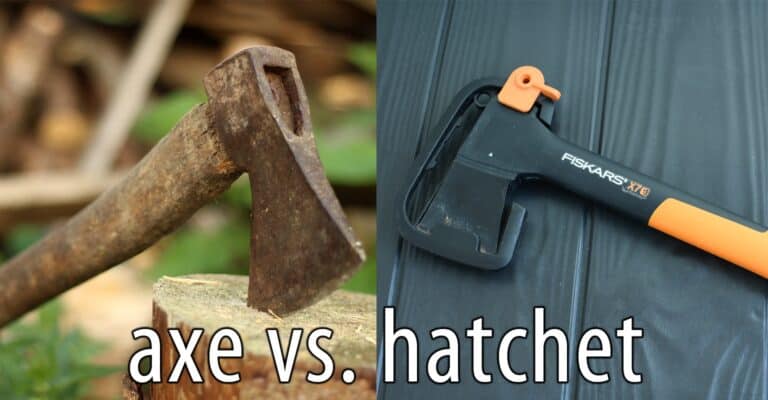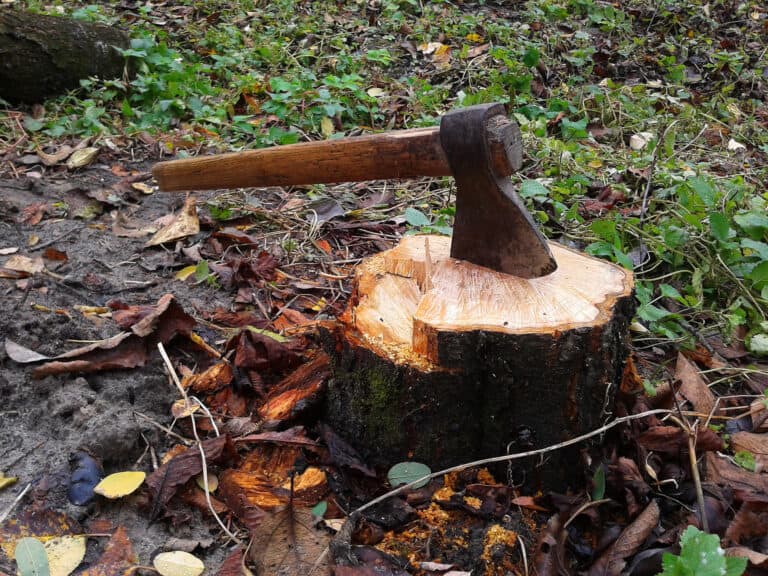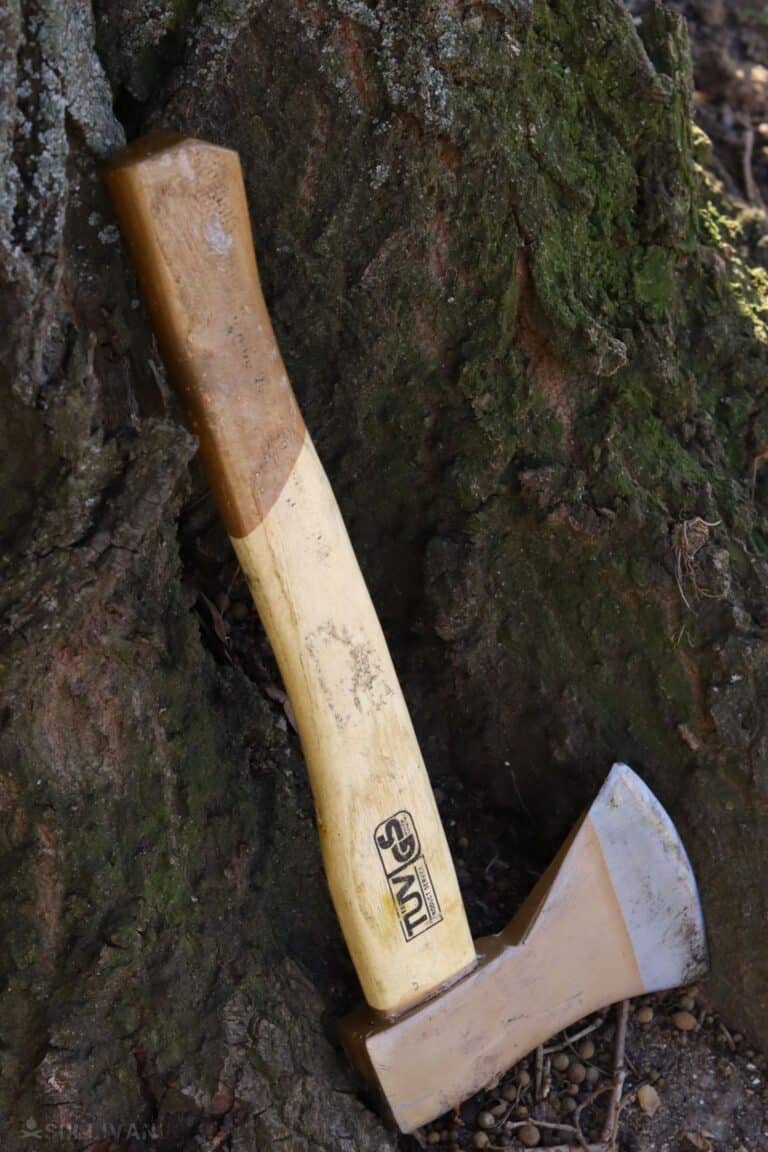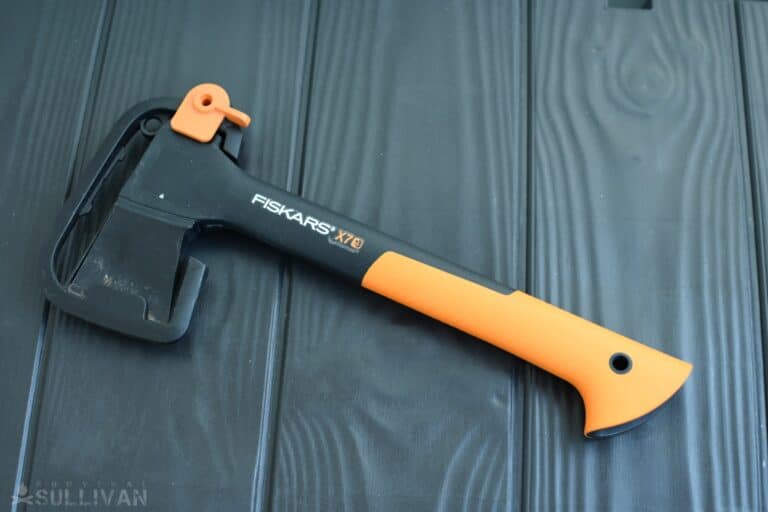Preppers and campers both often make use of wood chopping tools on their excursions for the processing of firewood, clearing of campsites and impromptu construction.

You will often see entire articles and conversations revolve around the subject of what tools you should take with you into the woods, and foremost among these choices are hatchets and axes.
Both of these wedge-shaped tools have their proponents, but many times you will see the terms used interchangeably, or nearly so in the course of conversation.
Naturally we should determine once and for all what the difference is between hatchets and axes; is a hatchet just a shorter axe? Are a hatchet and a hand-axe the same thing? Just what is the difference?
An axe is a longer, two-handed chopping tool that features a head with one or two bits. A hatchet is a single-handed chopping tool that’s also suitable for hewing in most configurations, with a hammer poll on the side of the head opposite the bit.
Of course there is a little more to it than this simple answer, but the simple answer suffices for most of us. If you want more details then read on!
Comparing Hatchets and Axes
While both a hatchet and an axe are designed to cut wood, they have very different characteristics that make them have their own strengths. Check out this overview of the differences between the two and what they excel at in the bush.
| Feature | Axes | Hatchets |
|---|---|---|
| Size | Longer handle Can be heavy Great for building shelters | Short handle Lightweight Great for hiking |
| Weight | 2 – 3 pounds (1 – 1.5 kgs) | 1.25 – 2 ponds (600 grams to 1kg) |
| Shaft Design | A long wooden handle means a larger grip More striking power with larger swing Long handle for two handed use | Can be a straight shaft or flared Much shorter for use with one hand |
| Head Shape | Steel head with a thick width. Different types of axes and axe heads including a felling axe, double bit axe, splitting maul | Still steel, but much smaller. One side is a cutting edge and the other is a blunted side |
| Usage | Made to be used with two hands | Made to be used with one hand |
| Uses | For heavier tasks such as felling down trees, splitting logs | For lighter tasks, including more precise cuts, splitting thinner logs, cutting small tree branches and saplings, kindling, hammering in tent pegs etc. |
Length of Haft
There is no genuinely definitive dimension that determines the length of the handle, or haft, of an axe or hatchet.
As I said above, an axe is a two-handed chopping tool that can potentially be used with one hand and so necessitates a much longer haft in order to generate the needed power.
A hatchet is only ever a one-handed chopping tool though you might be able to utilize it effectively with two hands, and so has a much shorter haft.
This comparison is further complicated by the existence of the hand-axe, a chopping tool nearly identical in configuration that fits between the axe and a hatchet in length.
Haft Features
Axes and hatchets are also similar when comparing the features of the haft, as well as the interface of the haft with the head.
A hatchet handle will most often times look exactly like a longer axe handle just on a smaller scale. It has a crook and swell at the bottom to prevent the hand from slipping off when it is swung and a tapered section that’s inserted through the eye of the head at the top, being secured with wedges or some other contrivance.
Notably, a hatchet does not have a straight, round haft; that is a feature of a tomahawk, another similar yet different tool intended for different purposes.

Head Features
For people who are not serious aficionados of axes, hatchets and other chopping tools the heads will probably look identical. Even for those with some experience any pronounced difference might be impossible to detect.
Typically, a hatchet will have a slightly steeper pitch to the head, and a more pronounced beard. This reflects its typical use as a limbing and hewing tool, and also the fact that it is designed to be swung with one hand.
Note that hatchets will never be had in a double bit configuration; if you have a smaller chopping tool that features double cutting bits, you have a double-bit hand-axe, not a hatchet.
In all other aspects save one they are broadly identical, and feature the same eye configuration for securing the head against the shoulder of the haft.

The Pole
It is the pole of the hatchet that makes it immediately distinguishable from an axe or a hand axe. A proper hatchet features a pronounced hammer poll on the side of the head opposite the bit. This hammerhead looks very much like the same protrusion on a conventional carpenter’s hammer.
Note that it is distinct from a flat poll that is nonetheless still utilized by many wielders for pounding and hammering; many small hand axes sold today that feature this flat poll are still labeled as hatchets, perhaps erroneously so.
Anytime you see a compact, one-handed axe that features this hammerhead protrusion opposite the blade you can be sure you are dealing with a real hatchet.

Common Misconceptions
A hatchet is not a tomahawk, though the two are often confused and even have similar features. As mentioned above, a tomahawk has a round or oval, straight haft with no swell or crook to it.
Compared to the head of a hatchet, a tomahawk’s is smaller and lighter, has a thinner bit, and may have another tool on the pole, a hammer, spike or a flat.
Tomahawks can be used as tools but were originally designed as weapons, and typically lack the sheer chopping performance in wood that hatchets have. They might also be a little bit longer than the average hatchet.
Most notably, tomahawks are designed to be easily dismantled or to have their hafts easily replaced.
This is because the heads only slip over the lower part of the half before sliding up to a swell at the top which keeps it securely wedged in place. It is far from uncommon for a tomahawks head to come loose during heavy use.
Now You Know the Difference
Hatchets and axes are definitely close cousins, but the two tools have distinctive differences that set them apart in both design and intent.
Axes feature a long haft, and a head with one or two bits, and are designed to be swung with both hands.
A hatchet is much shorter, featuring a similar head that is also equipped with a hammer head on the side opposite from the bit and edge, and is designed for one-handed operation.
Both are useful chopping tools, and definitely have a place in your survival tool chest, though only the hatchet is small and compact enough to be taken afield easily, especially when carrying a backpack.
Questions You May Have
Before you go out and purchase your next axe check out some of the most asked questions from people just getting into their first hewing tools.
Get an axe to split large pieces of firewood and a hatchet if you need something small for kindling.
They both excel in different situations; axes are great for large tasks and hatchets are lighter for easy carrying.
An axe can work as a hatchet in a pinch. A hatchet will require much more energy to fell a tree.

Tom Marlowe practically grew up with a gun in his hand, and has held all kinds of jobs in the gun industry: range safety, sales, instruction and consulting, Tom has the experience to help civilian shooters figure out what will work best for them.
